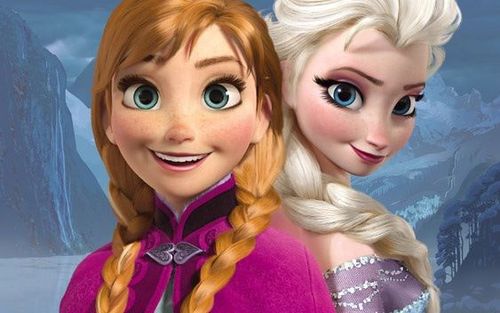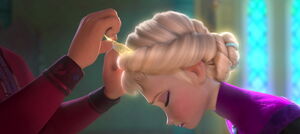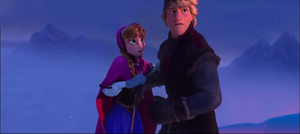The Disney princess paradigm is defined by a system of American ideological and aesthetic codes that are known to the Disney artists and their viewers. The heroine is recognized when she stands on a balcony letting her long hair blow in the breeze, when she sings in the forest, or when she wishes for that which is beyond her grasp…The attributes are visual, narrative, and musical. Although the specifics have been updated, revised, and reformulated to conform to contemporary ideology, the essence of the Disney princess formula has remained intact. As Walt put it, we always root for ‘Cinderella and the Prince.’
I wrote that in 1998 after completing an extensive two-year study on nine of Disney’s animated heroines. Now let’s flash forward 15 years to 2013. Disney has released the latest edition to its Princess Collection: Frozen. How has the princess formula been “updated to conform to contemporary ideology”? How has it “remained intact”? Why has this film been labeled “subversive?”
Inspired by Hans Christian Anderson’s story The Snow Queen, Disney’s Frozen tells the story of two princess sisters Elsa and Anna who live in the fictional Scandinavian land of Arrendelle. Elsa is born with the gift of ice magic which strengthens over time. After being crowned Queen, she accidentally freezes her kingdom and flees to a life of self-imposed isolation. The narrative continues as Anna journeys to save Arrendelle and, ultimately, thaw a long-frozen sororal relationship.
For fans of Anderson’s original tale, this film bears little resemblance. When Disney says “loosely-based,” the operative word is “loose.” For example, Anderson’s narrative is woven around a heavy Christian theological ethic. Gerda unfreezes Kay’s heart only by virtue of being a “Christ-child.” As for the film, there are several subtle visual suggestions of a Christian landscape; most notably in the coronation scene. Otherwise Disney’s Frozen is absent of any overt religiosity.
I point to the film’s ethical construction because that is the point at which Frozen deviates from the traditional. In typical princess films, the moral universe is constructed through the juxtaposition of recognizable good and bad characters. With few exceptions, witches, bad step-mothers, sorcerers, and Vodou priests are evil. The good “guys” are the princesses, would-be suitors and their cute little animal companions.
Frozen subverts this tradition by presenting a new ethical dynamic – a complexity that has yet to occur within any past Disney princess. The “evil” exists within its heroine: Elsa. She is born with magical powers which, as a child, she attempts to “conceal and not feel.” As noted by the troll king, magic can be used for good or bad. He demonstrates good magic as cued visually by blue, sky-like imagery. He demonstrates bad magic with red, subtle hell-like imagery. Here is a great example of covert religious iconography present in secular films.
Just after Elsa is crowned queen, her magic power is unleashed and she flees from Arrendelle. At this point, she ceases to be a princess-maiden and has become the queen-mother. The courtiers condemn her as a “sorceress and monster.” She becomes the movie’s witch. Interestingly, the writers offer a bit of symbolic foreshadowing when sister Anna walks by a painting and says, “Hi Joan,” referring to Joan of Arc the historical figure condemned of sorcery.
Here is where the narrative takes an ethical turn, subverting everything we know about Disney princess stories. When Elsa arrives at the top of a mountain, she begins her show-stopping song: “Let it Go!” She embraces her magic and transforms her life. The process is signified by Elsa’s visual change from a buttoned-up, high-collared dress to a shimmering, trailing gown with plunging necklines. As she walks out onto the balcony, hips swaying and hair flowing, Elsa demonstrates full control of her life, her magic and her sexuality.
No Disney female character has ever completely owned her magical existence within the narrative and remained “good.” No Disney heroine has been this free – even Pixar’s Merida (Brave 2012.) To be fair, Brave did twist the princess paradigm. Merida doesn’t find her true love before the credits role. It is important to note that both Pixar’s Brave and Frozen have the distinction of being the only two Disney-produced princess films with a female co-director.
Regardless of Brave’s twist, Merida doesn’t shun marriage. She just waits. Elsa is completely different. She is a heroine who is both magical and highly-sexualized – two traits usually reserved for wicked women. Fans of Broadway may almost hear Elsa singing:
Something has changed within me; Something is not the same.
I’m through with playing by the rules of someone else’s game…
It’s time to try defying gravity.
Perhaps that’s because Elsa is voiced by Idina Menzel, the actress who originated Wicked’s Elphaba on Broadway. More likely, Frozen and Wicked both negotiate female agency in the same way. Wicked tells the story of a socially-isolated woman who is labeled a “witch” and subsequently defies all convention to be herself. Frozen, in part, tells the same story. Both women are terrified of hurting those they love which they can’t seem to stop doing. Both women isolate themselves in a distant castle.
Unfortunately for Elphaba the stories don’t end the same. Elsa is allowed to remain a heroine, queen and witch. Although there are points where the “red light” does appear in her magic, she manages to remain good. We all know what happens to the Wicked Witch – despite Broadway’s silly rewrite.
With all of that said, Frozen doesn’t completely toss out the princess formula. Sister Anna lives in the more traditional story complete with ball-gown, a romantic kiss and endearing secondary characters. In fact, Anna is almost a repeat model of Tangled’s Rapunzel, both visually and narratively. In fact her male counterpart Kristoff and his reindeer, Sven, are repeats of Rapunzel’s Flynn Rider and his horse, Maximus.
However, Princess Anna does play a major role in the biggest subversion of the princess paradigm within the film. (Spoiler Alert) When Elsa inadvertently freezes Anna’s heart, the trolls reveal that only an act of true love can save her from the “witch’s” magic. We, and the characters, assume this to mean true love’s kiss. How many of these movies have we seen?
Think again. True love turns out to be the love between the two women. In the end, Anna sacrifices herself to save her sister’s life. That becomes the act of true love. No romantic kiss. No man. Just the two sisters.
While one of Frozen’s Princess story lines is subversive, the other is not. The crossing of the two challenges our expectations and ends with sisters rekindling their lost love without sacrificing who either of them has become – Witch Queen or Princess.

Anna and Elsa
From Disney Wiki
With Frozen, Disney hasn’t reinvented its formula, it just poked some serious holes in it. There are choices now. Going back to my original argument:
Although the specifics have been updated, revised, and reformulated to conform to contemporary ideology, the essence of the Disney princess formula has remained intact. As Walt put it, we always root for ‘Cinderella and the Prince.’
That still stands. We can root for Anna and Kristoff. However we can also root for the Snow Queen and her beautiful magic – the ice, snow and the melting that comes from her love.
The Wild Hunt is not responsible for links to external content.
To join a conversation on this post:
Visit our The Wild Hunt subreddit! Point your favorite browser to https://www.reddit.com/r/The_Wild_Hunt_News/, then click “JOIN”. Make sure to click the bell, too, to be notified of new articles posted to our subreddit.





Lovely write up! I’ve been going back and forth whether I want to see Frozen; fairy tales and how they represented resonate so strongly (It was reading Women Who Run With the Wolves’ analysis of fairy tales and archetypes which eventually drew me to Paganism), but sometimes Disney’s representations can be a let down.
That said, growing up as a little kid with The Little Mermaid and Beauty and the Beast, the magic and enchantment of the story lines seemed to stick with me more than what I could later see was disappointing reinforcement of simple roles for girls and boys. I’m glad to see a widening variety of plots and ideas.
Well now you’ve gone and done it, I don’t go see movies in the theater but now I want to check this one out! Thank you for a great write up, I loved the analysis.
“For fans of Anderson’s original tale, this film bears little resemblance. When Disney says “loosely-based,” the operative word is “loose.””
I guess I will wait for it to come out on disc, then. I hate what Disney do with the stories they get their hands on at the best of times.
Can I just point out something here? Princess and the Frog has 2 voodoo practitioners! The good and bad. The good: Mama Odie then Shadow Man (Dr. Facilier) as the bad guy. Disney pretty much illustrates that magic can be used for good and bad purposes. But yes, I liked the write up very much!
Edit: I can list off other Disney movies that don’t “demonize” magic.
Kristen, thank you for your comment. You are right. Disney doesn’t outright “demonize magic.” There are plenty positive uses of magic – Fairy Godmothers, Mama Odie, Grandma Willow etc. However magic is commonly used to define ethics within a complex reading of womanhood and female agency. Of course, there are trends – many of which come from the original tales – not Disney at all.
‘No Disney female character has ever completely owned her magical existence within the narrative and remained “good.” ‘Umm…Cinderella? Fairy Godmother? Maybe you meant female lead character.
I think the aurthor meant lead characters and not supporting characters… Besides, Cinderella had no magic of her own, she and her animals were enchanted by Fairy Godmother…
…who certainly owned her magic and was relentlessly good.
Thanks for comments on Fairy Godmother. She’s a wonderful iconic figure. But her characterization and purpose are very different from a heroine/Princess. The explanation of that difference is way beyond the limited space of Disqus comments. :>
Just took my 9 and 4 year old daughters to see this. I enjoyed it as much as they did and I love the fact that there were two very strong, independent female leads. There aren’t nearly enough of them out there!
Hi Heather! Just wanted to note: Wicked the Musical, is based on Wicked: The Life and Times of the Wicked Witch of the West by Gregory MacGuire (http://en.wikipedia.org/wiki/Wicked:_The_Life_and_Times_of_the_Wicked_Witch_of_the_West) Broadway didn’t re-write the story. Love the write-up though.
Love the write-up though.
Thanks, Justin. Actually I was referring to Broadway’s re-write of Maguire’s original story. The show’s ending is different than the book’s ending.